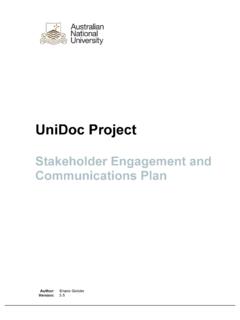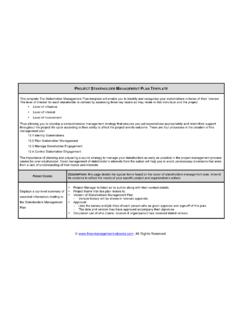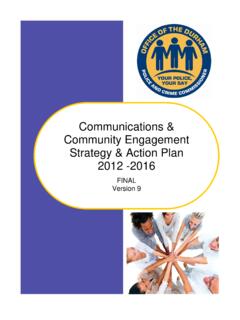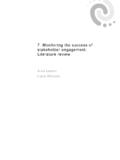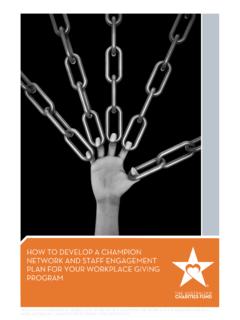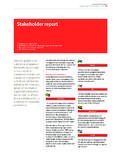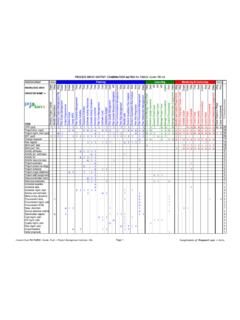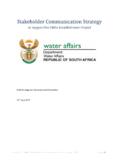Transcription of Communication and Community Engagement Strategy
1 Communication and Community Engagement Strategy Page 2 Royal Victoria Regional Health Centre Communication and Community Engagement Strategy Updated: Dec. '14. Table of Contents Overview ..3. RVH's Commitment to Communication and Community Engagement ..3. RVH's Communication and Engagement Principles ..4. What is Community Engagement ? ..5. RVH Engagement Tools and Tactics ..6. Patient Family Advisory Target Audiences ..7. Monitoring, Evaluation and Reporting Back ..7. Acknowledgements ..8. Appendix A Checklist for Planning and Conducting Community Engagement Activities ..9. Appendix B Communication / Engagement Plan ..10. Appendix C Evaluation Plan ..16. Appendix D Reporting Back Plan ..17. Page 3 Royal Victoria Regional Health Centre Communication and Community Engagement Strategy Updated: Dec. '14. Overview Decisions made in healthcare have far-reaching effects. What may seem like a minor change can cause significant ripples throughout the communities served, and within the health centre itself.
2 To ensure we are making the best decisions, preparing for impacts/reactions and informing all stakeholders, it's imperative that Royal Victoria Regional Health Centre (RVH) connect with our stakeholders during every step of the process from planning through to execution. This will help us build strong relationships and establish a two-way dialogue with the people affected or impacted by our plans. In addition, the Local Health System Integration Act, 2006 (LHSIA) requires health service providers (including hospitals) to "engage the Community of diverse persons and entities in the area where it provides health services when developing plans and setting priorities for the delivery of health services". Objectives The Communication and Community Engagement Strategy will: Demonstrate RVH's commitment to openness, timeliness and accountability in decision-making processes Build organization-wide commitment, culture and capacity for Community Engagement Bring diverse voices and perspectives into the planning and decision-making process Help RVH better meet the health needs of Simcoe Muskoka and identify service gaps, duplication and continuous improvement Enhance service quality, accessibility and system navigation based on Community feedback Improve people's health literacy, ensuring they can understand and use information to improve and maintain their health Engage our communities in health promotion discussions in order to provide a more significant and lasting impact on health Identify new opportunities to integrate services and smooth transitions of care Target resources where they are most effective and needed in the Community Build awareness, support.
3 Trust and confidence in RVH. Further enable RVH to fulfill its vision to Make each life better. Together.. RVH's Commitment to Communication and Community Engagement RVH is unwavering in its commitment to put patients and families first through our MY CARE philosophy, ensuring they are partners in their care and providing the most positive patient experience. Always and without exception. That means ensuring they are partners in their care throughout every step of their healthcare journey; informed and engaged in planning and decision-making. We believe Engagement is about giving stakeholders who may be impacted by a decision or action the opportunity to participate in the process, and help shape decisions before they are made. Real Community Engagement requires listening and learning, as well as informing and educating. Only through genuine two- way dialogue can RVH make better decisions that meet the needs of all stakeholders.
4 Page 4 Royal Victoria Regional Health Centre Communication and Community Engagement Strategy Updated: Dec. '14. RVH will communicate and engage stakeholders when: An issue affects the introduction of new and/or the reduction of existing programs and/or services The decision has long-term, large-scale or otherwise significant social, environmental, health and/or economic impact for one or more stakeholder groups ( access to service). An issue directly affects a significant group in the Community A significant number of people or groups are likely to have strong views on the issue There is already, or will be, public media scrutiny over the issue It is the expectation that all RVH programs and departments will develop and Engagement / Communication plan before launching new initiatives and services. RVH is aligned with the North Simcoe Muskoka model of Communication and Community Engagement . RVH is a member of the LHIN Communications Council, providing strategic Communication and Community Engagement recommendations to the Care Connections Areas of Focus Councils and their corresponding Project Steering Committees, supporting the LHIN to achieve its vision of Healthy People.
5 Excellent Care. One System. RVH's Communication and Engagement Principles At RVH we believe true Engagement goes beyond just informing various stakeholders about new initiatives or projects. It means seeking broad input to ensure we are considering, responding to and meeting the needs of all stakeholders. We are committed to these principles: Transparent Inclusive We will engage stakeholders in an open process We will invite broad participation, considering with transparent purpose, goals, expectations, visible and non-visible challenges such as accountabilities and constraints. We will be open socioeconomic status, cultural beliefs/traditions, about how the Engagement will be used in language or disability. decision-making. Timely Respectful We will engage stakeholders early enough in the process to make a difference in We will treat stakeholders with courtesy, dignity decision-making. We will provide timely and respect, while being responsive to their feedback and let participants know how their unique perspectives.
6 Input was used. Effective Appropriate We are committed to reflecting stakeholder We will use methods of Engagement that are feedback in our plans and actions. We will appropriate to the purpose, while engaging monitor the effectiveness of Community stakeholders who are most affected. Engagement strategies. Page 5 Royal Victoria Regional Health Centre Communication and Community Engagement Strategy Updated: Dec. '14. What is Community Engagement ? Although there is no universally accepted definition of Community Engagement , the World Health Organization (WHO) defines it as a process by which people are enabled to become actively and genuinely involved in defining the issues of concern to them, in making decisions about factors that affect their lives, in formulating and implementing policies, in planning, developing and delivering services, and in taking action to active change.. The International Association for Public Participation (IAP2) and the WHO have identified levels of Engagement and these have been adopted by the Local Health Integration Network Collaborative (LHINC).
7 1. Inform 2. Consult 3. Involve 4. Collaborate 5. Empower less active When To Use Tools & Tactics Goal Publications, newsletters, press Provides clear, balanced information releases, Public Service Inform to assist in understanding issues, Announcements, advertising, fact options and opportunities. sheets, FAQs. Surveys, opinion polls, Community When the objective is to gather outreach, public forums, social media Consult information, analysis and feedback comments, written submissions, Town from a variety of stakeholders. Halls. More participation Active participation from stakeholders Patient groups, committee membership, Involve ensures issues and concerns are stakeholder research, focus groups. understood and considered. Working together in the decision- Patient and Family Advisory Council, ad Collaborate making process and incorporating hoc committees, one-on-one recommendations into the decision.
8 Consultations. Actively partnering with stakeholders Patient and Family Advisory Council, Empower and sharing final decision-making. working groups. ** Different levels of Engagement and tactics are used depending on the objective and need. Page 6 Royal Victoria Regional Health Centre Communication and Community Engagement Strategy Updated: Dec. '14. RVH Engagement Tools and Tactics RVH currently uses many tactics to engage and communicate with its stakeholders, including (but not limited to): Bedside electronic survey for patients/families Paid advertising (predominantly print). Post-discharge patient calls Social media (YouTube channel, Twitter, Personalized information letters Facebook). Community Forums / Open Houses Videos on website Workshops Website postings including safety indicators ( hand hygiene, infection Focus groups rates), Board of Directors meeting One-on-one discussions minutes, executive contracts and Surveys/questionnaires expenses Telephone and in-person Town Halls Fact sheets/information brochures Newsletters Community outreach, including Feedback option on website presentations and speeches Feedback post-cards for patients and families Events Elected Officials presentations and meetings, Speakers' Bureau including annual tour Communications Calendar Robust media relations Strategy , including: Issues management and crisis Three times weekly television series communications providing health news Participation in external committees, Monthly newspaper feature councils and purposeful partnerships Radio Public Service Announcements on 6.
9 Local radio stations Annual Report magazine distributed to all homes in the region Patient Family Advisory Council RVH's Patient Family Advisory Council (PFAC) is the cornerstone of Community Engagement and RVH's patient-centred Strategy . The Patient Family Advisors represent the voice of the patient and families. Their experience, insights, expertise and perspectives are invaluable to improving care. The Patient Family Advisory Council is an opportunity for patients and families to participate as partners in care and shape the patient experience at RVH. They partner with RVH's staff and physicians to provide direct input into policies, programs and practices which affect the patient experience. It is only when we see healthcare through the eyes of patients and their families that we can improve their experience. Page 7 Royal Victoria Regional Health Centre Communication and Community Engagement Strategy Updated: Dec.
10 '14. Target Audiences RVH believes everyone is a potential stakeholder because, at some point, nearly everyone has a direct experience with the health centre and they as well as their families -- will be impacted by the decisions we make. Stakeholders include, but are not limited to: Patients and families Visitors Staff, physicians and volunteers Healthcare partners Community partners Donors Elected officials Funding partners General public Media It is also important to recognize that people define themselves by which communities they feel part of, including: Geographic communities such as municipalities or defined neighbourhoods Non-geographic communities of common interest based on age, gender, ethnicity, disability, language, demographics and cultural communities Communities of interest or common experience such as patients with similar needs Communities of shared beliefs Monitoring, Evaluation and Reporting Back Effective Community Engagement requires on-going monitoring, evaluation and reporting back.
